Seasons – Fall 2012

Dear friends of Plateau,

Tim Milligan, Interim Director of Sales and Marketing
Fall is a time of abundance and celebration. Our Seasons banner photo of a very healthy turkey reminds of this abundance, and of the beginning of the holiday season. The weather is showing signs of cooling after another hot, Texas summer, inspiring us to spend more time outdoors in nature. There is a lot to be thankful for this time of year.
At Plateau, we’re gearing up for another season of seminars, in which we travel around Texas spreading the word about the many benefits of maintaining Ag through Wildlife Management (for dates and locations, click HERE). We’re also trying some new things out, like Wildlife Management Activity Check-Ups and Wildlife Management Activity Highlights. These are 2 new services that we’re very excited about offering our clients so be sure to follow the links and read on. And we always want to remind every one of our enhanced capacities through our construction division, Plateau Land Use Services (PLUS).
You’ll also notice that we’ve changed the layout of Seasons in this issue, including only summaries of each article with links to the full story on our website. Over the past few years, Seasons has gotten pretty long so this was our attempt at making the email version a lot more navigable for our readers. This new approach will also allow you permanent, easy access to this issue and previous ones on our website at any time.
At Plateau, we are thankful for all of you- our clients, friends, and colleagues- who have made the commitment to enhance and preserve our great, Texas wildlands. You make our job a joy, so if there’s anything we can do to help make your fall more abundant- from pond enhancement and brush clearing to increase your enjoyment of your land, to discing and strip mowing to improve your dove population this hunting season- do not hesitate to call us.
Until next season and Seasons,
Tim Milligan
Interim Director of Sales & Marketing
Plateau Land & Wildlife Management
(512) 894-3479
[email protected]
Table of Contents
Improve your Dove Hunting Success This Season
A Man and His Land: A Plateau Land Uses (PLUS) Success Story
Announcing: Fall 2012 Wildlife Exemption Seminars- Sign Up Now!
A 3-Part Series on Understanding the Condemnation/Eminent Domain Process
Introducing: The Braun & Gresham Landowner Alert System
Fall Wildlife Management Activities Checklist
Annual Reports and Wildlife Management Activities Check-up
Introducing: Wildlife Management Activity Highlights
Get to Know Plateau
The Opportunity of a Lifetime
We Can’t Do It Alone
Improve your Dove Hunting Success This Season
By Kasey Mock, Account Manager
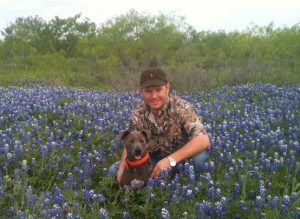
Kasey Mock and his Blue Lacy, Maya are great hunting buddies during dove season.
The morning of Sept 1st found me anxiously nestled alongside an overgrown fencerow, leading to a mostly dry pond, surrounded by intermittent dead snags. My three-year-old Texas Blue Lacy, Maya, quivered each time I would raise my head to the near horizon. It was opening morning of dove season in the Central Zone and she was in full retrieval mode!
Each year, approximately a half million Texas wing shooters take to the field, according to the Houston Chronicle, making this the most sought after migratory game bird in the state. For the dove-hunting enthusiast and savvy landowner, there are a few easy management practices you can implement to attract more birds. For example, attracting mourning doves is relatively simple if you understand their behavioral patterns:
- Mourning doves roost in trees and dead snags
- They prefer to feed on open, exposed soil
- They are easily tracked along linear travel corridors and around water sources
Landowners can capitalize on these predictable patterns by conveniently providing all the basic necessities (food, water, and shelter) on their property. This can be achieved with food plots, strip discing, strip mowing, snag development, and pond enhancement.
Properly designed food plots are planted in strips consisting of sorghum, millet, sunflower, or other preferred plants, which attract birds and provide bare ground*. Strip discing improves pastures, providing bare ground for birds to forage for seeds and encouraging weedy plants like croton. Similarly, strip mowing creates an edge effect and knocks down seed for easy feeding. Existing ponds can be enhanced for many species of migratory birds, including dove and waterfowl by providing exposed beach areas or by simply lowering the water level, making them more accessible for these birds. Most will not need help with snag development considering the tree mortality we are experiencing due to the drought, but if you are planning on clearing some brush this season, be sure to leave a few dead trees to improve dove populations on your property.
Plateau can assist you in designing and implementing all of these activities for a more productive dove season. The rest just depends on your ability to shoot!
From the field,
Kasey Mock
*Disclaimer: Plateau does not condone seed baiting of migratory birds and none of the activities outlined in this article is defined as such. For more information about the rules and regulations on hunting migratory game birds, please see the Texas Parks & Wildlife website: http://www.tpwd.state.tx.us/regulations/fish_hunt/hunt/migratory/. As a responsible hunter, you should be familiar with the laws and obey them.
Back to TopBack to Top
A Man and His Land: A Plateau Land Uses (PLUS) Success Story
By Erica Fick, Marketing Coordinator
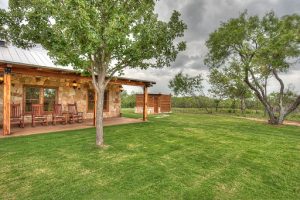
Hugh Menown’s beautiful 227 acres in Guadalupe County. Photo courtesy of Hugh Menown.
When Hugh Menown purchased 227 acres of rural land in Guadalupe County in April 2011, it was covered in 20 years of untamed mesquite growth and boasted 4 ponds with little to no water. From the beginning, he planned to improve and restore the ranch, but for a new landowner who lives and works in Houston, he would need some help with both direction and implementation. So, he hired the professionals at Plateau Land Use Services (PLUS) to help him identify his goals for the property and develop a comprehensive plan to realize his vision.
Preserving the History of the Land
For the past few decades, Menown’s land has been used for grazing cattle and he decided to keep it that way. Maintaining his Ag valuation was important to him since the previous owner leased the land to a tenant who’d been grazing cattle on his newly acquired property for more than 20 years. “I know that running cattle isn’t the greatest for my land,” explains Menown, “ but Mr. Dietert has been here since the dinosaurs were around and my land is a part of his life.”
The Kingsbury, Texas property was also once home to the Mobil Recreation Facility, or what was called the Magnolia Country Club back in the 1930s. Mobil Oil executives would go there on the weekends to play the 9-hole golf course, enjoy square dancing, and even bowling. Now all that remains is a small house that Menown has now renovated as a weekend home for his wife and family.
“We knew we were going to do something with the house,” explains Menown, “ but the question was, what do you do with the rest of the property?”
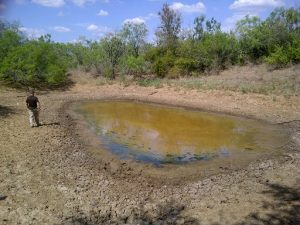
1 of 4 Menown ponds before its PLUS renovation.
The Improvements: 4 Pond Renovations and a Whole Lot of Brush Clearing
A friend of Menown’s who owns a ranch in nearby Seguin, recommended PLUS as the company to help him answer this question. So, he met with Kasey Mock, Business Development Coordinator at Plateau and PLUS to first evaluate his needs.
“Kasey carved out an entire weekend to spend with me,” explains Menown. “When we were driving around my property, he said to me, ‘Hugh, you could hire somebody else to dig a hole in the ground, but they’re not going to deliver the same quality pond as we would.’ I really appreciated that honesty.”
After deciding to move forward with renovating all 4 ponds on his property, Menown’s next step was to meet with John Melnar, General Manager at PLUS and Project Manager on his project.
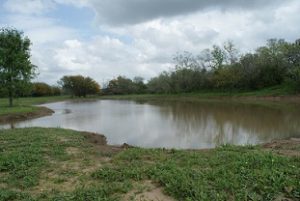
Menown’s pond AFTER its PLUS renovation.
“When we first meet with a client, we try to help them visualize what’s in their mind, match that with their budget, and balance what’s best for the entire property,” explains Melnar. “ Some folks think they want a 5 acre pond, but after we physically map it out on the site location, they realize that what they really want is only a 1 acre pond. PLUS helps them realize these kind of things.”
Taking advantage of the drought, the PLUS team went to work in September analyzing the watershed for the best site location, clearing brush, cleaning out, reshaping, re-lining, and deepening the ponds (even doubling the size of one of them) to finish the project by the end of October.
“When you’re doing something like this for the first time, you don’t know what to expect,” explains Menown. “ But the PLUS team did an outstanding job and made me feel like they really cared about my property. We got some rain that winter and the ponds filled up nicely.”
A Man and His Land
There are many benefits to creating and maintaining water features on your property- supplemental water for livestock, erosion control, enhanced wildlife habitat, improved property value, and a place of relaxation and recreation. For Hugh Menown, improving his ponds meant increasing the value of his land, preserving a piece of history, and investing in a little bit of peace.
“I can just sit on the back porch and all I hear are the birds, donkeys and cows in the distance…I really enjoy being out there,” explains Menown. “It’s cliché, but there’s nothing like the relationship between a man and his land.”
Plateau Land Use Services (PLUS) is a unique subsidiary of Plateau that provides construction services to owners of rural land. From ponds and lakes, to live water and wetlands, we can create, enhance, or repair your water features to help you achieve your land management vision. Contact us today for a custom quote or visit our website for more information. We look forward to helping you enhance your enjoyment of your land!
Back to TopBack to Top
Announcing: Fall 2012 Wildlife Exemption Seminars- Sign Up Now!
By Erica Fick, Marketing Coordinator
Many of you receiving this newsletter may already be in Wildlife Exemption, but if your property, or someone you know, is in Ag or market value, you should consider making the switch to Wildlife. “Wildlife Exemption” (Wildlife Management Tax Valuation) is a compelling alternative to Ag because it allows you to enjoy the same low tax valuation while also benefiting from:
- No livestock or fencing requirements
- Enhanced recreational value
- Improved habitat
- Increased wildlife diversity
- Returning your land to its pre-grazing condition
Please join us at one of our 14 seminars across Texas this fall to learn more about the many benefits of switching to Wildlife. CLICK HERE to see our calendar of seminars and more information on event locations and times.
Back to TopBack to Top
A 3-Part Series on Understanding the Condemnation/Eminent Domain Process
By Erica Fick, Marketing Coordinator
Eminent Domain is a process by which private and public entities condemn private lands for public use. It comes in many forms- transmission lines, pipelines, rail systems, roads- and it’s affecting thousands of rural landowners across Texas. In this 3-part series on understanding the condemnation process, Patrick L. Reznik, an attorney with sister firm Braun & Gresham, answers a few common questions about the rights of Texas landowners threatened by eminent domain. Click the title below to read the full story.
Part 1: I Received a Letter Saying They’re Taking My Land…Now What?
In Part 1 of this series, Patrick explains what to do when you receive a letter of initial offer from a utility company or condemning agency, what your rights are at this stage in the process, and what the first steps are that you should take to protect your land and your rights.
Part 2: Negotiating Your Terms and Compensation
In Part 2, Patrick explains the importance of working with an attorney to help negotiate the terms that best fit your needs. From knowing when to accept an offer from a utility and negotiating the best easement to protect your property, to hiring the right appraiser and ensuring that you get fair compensation for damages. Working with skilled counsel is essential to navigating the complex condemnation process.
Part 3: Special Commissioner’s Court- When Settlement Negotiations are Not Enough
If negotiations have stopped, then the condemning company will file a condemnation proceeding in the District Court and serve the landowner with a lawsuit. In Part 3 of this series, Patrick describes how Braun & Gresham has experience in preparing and presenting clients’ cases to the Special Commissioners with favorable results.
Give us a call today to begin developing a plan of action for how you want to challenge your private or public condemning agency. At Braun & Gresham, we represent landowners exclusively, so we always have your best interests in mind. We bring authority and expertise to the condemnation process which translates to a place at the table— a place that is invaluable in a seemingly helpless process.
Introducing: The Braun & Gresham Landowner Alert System
By Erica Fick, Marketing Coordinator
Our sister law firm, Braun & Gresham is now offering the Landowner Alert System to help our clients and colleagues stay informed on issues affecting landowners and their land. This free e-mail service gives subscribers exclusive access to a range of information from announcements about important changes in the law to alerts about upcoming educational seminars. Anyone interested in land will benefit from a subscription.
Sign up now! http://www.braungresham.com/contact-us/#contact
And to see an example of the types of alerts that we send out, visit our News & Events page, or like us on Facebook!
**We will limit the Landowner Alert Service to a maximum of 4 e-mails per month and you can also unsubscribe at any time.**
Back to TopBack to Top
Fall Wildlife Management Activities Checklist
By Kameron Bain, Business Development
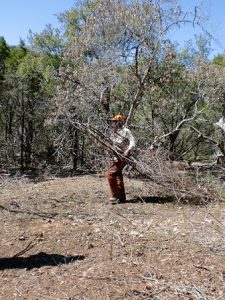
Are you on track to complete your wildlife management activities this year? Give us a call and let us help!
Hooray! It is finally fall. Temperatures are starting to cool down, which inspires us all to spend more time outdoors. Fall is also a reminder that 2012 is quickly winding down. Therefore, it is important to make sure you are on track with all of your wildlife management activities and that all activities are well documented. The good news is that if you still need to meet one of your Wildlife Management requirements for 2012, there are plenty of fall activities to choose from.
- Brush Management
- Wildlife Management Activities Check-up (see article below for more)
- Wintering and Resident Bird Survey
- Remote Camera Mammal Survey
- Imported Red Fire Ant Control
- Re-seeding Wildflowers and Native Grasses
- Strip Mowing and Discing (start November 1st)
- Chemical Control of Huisache and Prickly Pear
- Cut-stump Herbicide Treatments
- Tree and Shrub Planting (start late fall/winter)
- Brush Pile Construction
- Product Installations (feeders and supplemental shelter)
Back to TopBack to Top
Annual Reports and Wildlife Management Activities Check-up
By Kameron Bain, Business Development
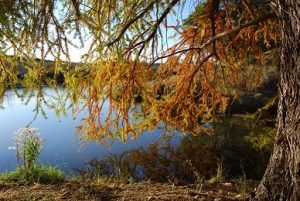
The Wildlife Management Activities Check-up is designed to give landowners guidance and peace of mind when preparing for Annual Report requests.
Over the past few years, the team at Plateau has noticed a trend of more Central Appraisal Districts (CADs) requesting Annual Reports for Wildlife Management properties. With the end of the year quickly approaching, we want wildlife management landowners to be aware of this trend and remind them of the importance of keeping good records.
This year, Plateau is offering a new service called the Wildlife Management Activities Check-up, which is designed to give landowners guidance and peace of mind when preparing for Annual Report requests. A Plateau Wildlife Services Technician , knowledgeable in CAD requirements and activity guidelines, will review your wildlife management activities on-site to make sure your property is in compliance for a potential CAD visit, Annual Report request, or to make sure you are on the right track with your wildlife management activities.
CADs request Annual Reports to document Wildlife Management activities in place of a site visit, therefore documentation for your 2012 Wildlife Management Activities is key. We can never stress enough that it is imperative that all qualifications are met and well documented for each year. With only three months left in 2012, we recommend that you review your activities and documentation so that you are prepared. Our Wildlife Management Activities Check-Up is a great way to do this.
Back to TopBack to Top
Introducing: Wildlife Management Activity Highlights
By Erica Fick, Marketing Coordinator
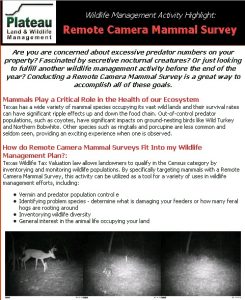 Every month, Plateau will highlight a different wildlife management activity as a courtesy to our clients in Wildlife Exemption. The Activity Highlights feature how each activity fits in your wildlife management plan, what type of activities qualify, and what kind of solutions Plateau offers to help you check another annual wildlife activity off your list. Our hope is that this email service will provide you with new ideas for maintaining your wildlife exemption, as well as serving as a reminder to keep you on track year-round with your wildlife management activities.
Every month, Plateau will highlight a different wildlife management activity as a courtesy to our clients in Wildlife Exemption. The Activity Highlights feature how each activity fits in your wildlife management plan, what type of activities qualify, and what kind of solutions Plateau offers to help you check another annual wildlife activity off your list. Our hope is that this email service will provide you with new ideas for maintaining your wildlife exemption, as well as serving as a reminder to keep you on track year-round with your wildlife management activities.
For an example of our latest Wildlife Management Activity Highlight: Remote Camera Mammal Surveys, CLICK HERE.
Want to make sure you get on our mailing list for this service? Contact Marketing Coordinator, Erica Fick at [email protected] to sign up.
Back to TopBack to Top
Get to Know Plateau
By Kameron Bain, Business Development
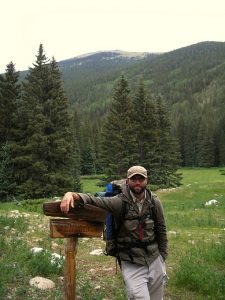
Chance Boatright, Wildlife Management Services Technician enjoying the outdoors at the Santa Fe national Forrest, New Mexico.
Chance Boatright- Wildlife Management Services Technician
Chance has made quite an impact in his department since he started working at Plateau as a Wildlife Management Services Technician one year ago. Not only has he been busy with his day to day technician duties, but he has also been essential in helping the Products & Services division implement the use of new technologies such as Ipads and Iphones to help improve efficiency out in the field.
Chance’s combination of love for the outdoors and his kind, positive disposition makes him an ideal person to handle the variety of responsibilities required of a Plateau technician- from product installs to brush management to site monitoring visits. The variety of activities and being outdoors are some of the perks for Chance. “I enjoy the fact that I love my job in every aspect,” explains Chance. “I never really feel like I am working. I like the fact that I am constantly outdoors …and every day is always different than the previous.”
This same passion for spending time outside extends to his time off as well. You can usually find him flying fishing, mountain biking, backpacking or just simply sitting on his back porch in his spare time.
Technician Manager Lee Kothmann agrees that Chance is a good fit: “Since being hired on as a field technician, he has proven himself not only to be conscientious, hard-working, and reliable, but also innovative in using his varied skill sets to bring new technology into streamlining the Products & Services Division’s documentation process. Typically soft-spoken, his easy going demeanor and slightly sarcastic sense of humor make him an enjoyable person to share the work day with.”
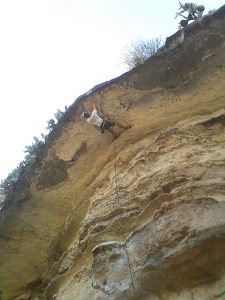
Zach Stark, GIS Specialist and Project Manager climbing the Seismic Wall at the Barton Creek Greenbelt in Austin, TX.
Zach Stark- GIS Specialist and Project Manager
Zach is another team member who is currently making an impact at Plateau. Over the past year, Zach has played a significant role in creating the new Mapping Department.
Zach started working at Plateau in May 2008 as a Wildlife Management Services Technician a week after graduating from Texas State with a B.S. in Geography: Resource & Environmental Studies. Due to his hard work and dedication as a Technician and Project Manger, he was recently promoted to GIS Specialist-Lead Cartographer. “Zach has taken on the new role of GIS Specialist with enthusiasm and initiative, and has made a big impact on our consulting and customer service capabilities in a short period of time,” says Senior Biologist Shane Kiefer. “I have high expectations for what he will be able to accomplish in the future.”
As lead Cartographer, Zach is responsible for coordinating and managing all Geographic Information Systems (GIS) and mapping activities. If creating maps for wildlife management plans, habitat assessments, and other larger mapping projects don’t keep him busy enough, he still works as a Project Manager, providing comprehensive oversight on wildlife management services for large properties.
When Zach is not working on maps, you can find him chasing a new “thrill or adrenaline rush” rock climbing. He also enjoys backpacking, camping, hiking, fishing, and playing the guitar, which he has played since the 4th grade. Being born and raised in Texas means a lot to Zach and he is happy to work with a team that shares his same goals. He says, “I like to think I’m doing my part in a small way to help keep Texas a wild and beautiful place.”
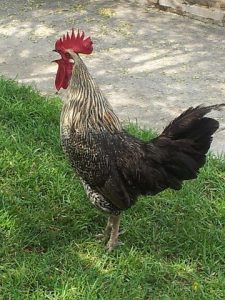
Pedro Fernando, Resident Rooster and Plateau Mascot greeting visitors with a “cocka-doodle-do” at the Plateau office entrance.
Pedro Fernando- Resident Rooster and Plateau Mascot
Pedro Fernando ruffled a few feathers when he wandered on to the scene 3 weeks ago. He was first discovered by Products and Services Manager, Steve Parker after a long evening on a deer survey. “He was standing on the hood of my truck,” explains Steve, who took another truck home so as to not disturb the proud rooster. “We have no idea where he came from, but from the looks of him, he was well taken care of by someone.” Plateau staff members have tried finding this bird a home but he seems to like it here.
Pedro’s job consists of “cocka-doodle-doing” at every sunrise, clearing bugs from the office entrance, and greeting visitors. However, one disgruntled employee, Mark Gray, Senior Biologist at Plateau, finds Pedro to be quite a lazy coworker. “He’s always laying around in the bushes and taunting me from my window sill with his ‘cocka-doodle-doing,” explains Mark. “All I’m saying is that we should probably have a chat with HR.”
In his free time, Pedro the rooster loves to eat, roost in the bushes, and enjoy the great outdoors. Staff Biologist, Kyndal Anderson is known to bring our new friend the occasional sweet treat. As she explains it, “Pedro is particularly fond of fruit, grapes being his favorite.”
As a wildlife management company, most of the Plateau staff is pretty delighted to have this friendly bird hanging around, and we’re sure you will be too. Come stop by and say hello sometime!
Back to TopBack to Top
The Opportunity of a Lifetime
By Craig Bowen, Account Manager

Craig Bowen’s newborn baby girl, Kyleigh at 1 day old.
I was driving down the road talking to myself the other day. Well, really I was not talking; the conversation was all in my head. And, really, I was not on both ends of this dialogue, as the other end of the exchange was held by my unborn daughter. Kyleigh will arrive any day now, and I am having trouble thinking about much else. She is planned to be our second of two children, the sister to 2-year-old Carter. Obviously, my wife Jessica and I learned a lot getting Carter through his first 27 months, so I was reflecting on those lessons as preparation for doing it all over again.
In my hypothetical conversation, young Kyleigh had asked me to impart to her the most useful advice I could give her at this stage in both our lives. As I write this, I am 5 days away from my 29th birthday. Yes, I know I am not old, and do not feel so most days, but beginning the last calendar year of my twenties feels like a milestone, of sorts. I remember when I began this decade, halfway through college and about to be married. I wondered, as most young people do, where I would be in 10 years, how I would get there, and if I would exceed my own vague expectations. So, pulling from that consideration, I answered her:
“Opportunity. Opportunity comes in various forms. Happenings such as lucrative job offers, chance encounters in romantic locales, and winning lottery tickets lying unclaimed on the sidewalk define opportunity for most folks. However, love, money, avocation, friendship, birth, and death all represent opportunity. Opportunity is perhaps the only thing you can ever be given, as it may be the only truly free thing in life. You can do with it what you want – nothing is lost if you do not take it, but anything can be gained if you do. Most do not see it until it is gone, but anyone can sense its arrival. And that, I believe, is the greatest advice I have at this point in my life – always seek opportunity, and in both the striking and mundane parts of life. If you seize opportunities as they present themselves, more will follow.”
Kyleigh’s great opportunity is her lifetime, and all the opportunities she will seize within it. I hope she, like the rest of her family, comes to view land and landownership as an extraordinary opportunity as an opportunity to grow and care for things, to share the non-renewable while it still exists, and to claim and preserve a legacy. Your land may be a culmination of seized opportunities, like a luxury car or a fine watch; it may be a way to make money, a chance to create other opportunities for you and your family; it may simply be the opportunity to keep something which has belonged to you or your family for generations. Whatever opportunities your land represents for you, always seek more and seize them…more will surely follow.
Back to TopBack to Top
We Can’t Do It Alone
By Terry Tull, Co-Founder of Protect Our Water Rights Texas
We are reprinting this article by Terry Tull, Co-Founder of Protect Our Water Rights Texas, as a way to keep our clients informed of recent developments in the groundwater conservation community. Those who are interested in learning more about Protect Our Water Rights Texas should contact Terry directly or visit www.protectourwaterrightstexas.org.
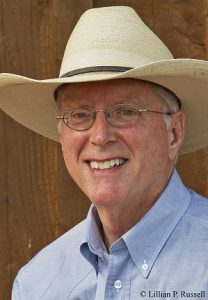
David K. Langford on his family’s portion of the historic Hillingdon Ranch near Comfort, Texas. Photo courtesy of David K. Langford.
David K. Langford tells an eloquent story about his family’s longstanding connection to the land, and about a problem he is facing that is bigger than even he can deal with. With an earnestness that reveals his passion, David describes how his ranch’s natural springs and creeks that are so vital to the health and diversity of his land are being jeopardized by an external threat over which he has little to no control. Many of you may have heard David tell his story, and some of you may be living a story similar to David’s. It goes like this…
Long ago – in fact, some 7 generations ago – David’s ancestors settled where he lives today – on his family’s part of the original 13,000 acre ranch near Comfort, Texas. Over the generations, through one family’s continuous and enlightened management, the land has flourished. Over those many years, his predecessors developed a love of the land and honed the skills of land stewardship that today make David rightfully proud of his family ranch’s success. For years, David has shared his land stewardship acumen and passion with others through his involvement as one of the Texas Wildlife Association’s original and continuing leaders , and through his many other activities.
David’s creeks and streams add important value to his land and the surrounding Hill Country. They are not only essential for his ranching and hunting enterprises, but also for sustaining the wildlife habitat that creates a complete and healthy eco-system that makes his land so productive – and which features in his well-known photography. His land, he says, is but a tile in a greater mosaic that makes up the Texas Hill Country, a land of diverse landscapes, wildlife, and communities that prosper from the bounty and beauty the land bestows on us all.
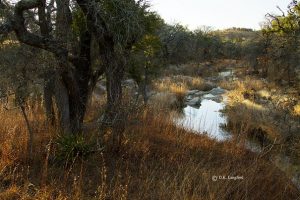
Water is life to a landowner, but our water is being depleted and landowners can’t prevent it by acting alone. Photo of Block Creek taken by David K. Langfod about 150 yards from his home on the Hillingdon Ranch at sunrise. To see more photography by David, visit his website: www.westernphotographycompany.com
But, David says, his family’s wells and springs are dropping precipitously – not just from the recent drought – but from overuse of the groundwater sources that supply them. And when groundwater dries up, so do the creeks and streams that are fed by it, and so forth down the whole riparian system. It is a pattern of loss that we have been seeing for a long time, but only now are we realizing its increased rate of acceleration due to the fragmentation of Texas ranchland and the resulting draw on our aquifers. As good as David’s family may be at stewarding their land, and at keeping their water use within the carrying capacity of the land, he is being undermined by the harmful actions of others who have not been restrained in their use of available groundwater.
The resulting loss of groundwater, and thus spring and stream flow, is imperiling all the benefits that flow from their land. It is destroying the value David and his extended family have built over generations, and it is also negatively affecting all of the land around them, including the communities downstream. And, it is happening all across the Hill Country.
David’s family alone, can do almost nothing to prevent or alleviate these problems. But together, with others who also acknowledge the threat to our aquifers, they have a fighting chance at restoring a balance to our state’s use of groundwater.
When I heard David tell his story recently, he was speaking at a fundraiser for Protect Our Water Rights Texas, a new group that has formed to protect our limited groundwater resources and balance competing groundwater rights for the good of everyone.
Protect Our Water Rights Texas is a non-partisan organization that believes protecting our groundwater is too big an issue to be left solely to politicians. They believe in the rights of individual landowners, and that the use of our limited groundwater assets needs to be sensibly and appropriately regulated to remain in balance with the available water in our aquifers. Unreasonable, over-exploitation of groundwater must be stopped for the good of Texas.
Protect Our Water Rights Texas is working for thoughtful changes in the management of our groundwater conservation districts, in our legislature, and in our laws. They are also working to elect leaders who understand the big-picture issues related to groundwater depletion, and who will use science-based tools and proven land stewardship methods to help manage these limited resources. Protect Our Water Rights Texas will actively enter the political arena with the Public’s interest in mind by supporting candidates and legislation to defend our groundwater rights.
You can learn more about Protect Our Water Rights Texas at www.protectourwaterrightstexas.org.
David K. Langford recommends landowners take these actions to protect and preserve their groundwater:
- Implement improved water management and conservation practices as key elements of your own land management efforts.
- Support conservation initiatives that not only conserve land, but also water resources.
- Work with other landowners and the general public to increase their awareness of the threats against our groundwater.
- Support candidates who will protect our groundwater at the Groundwater District, County, and State levels.
- Communicate your concerns to your elected officials at all levels.
- Support organizations such as Protect Our Water Rights Texas, which is working to protect landowners’ groundwater property rights through enlightened science-based regulation and legislative actions: www.protectourwaterrights.org.
</ br>
Back to TopBack to Top


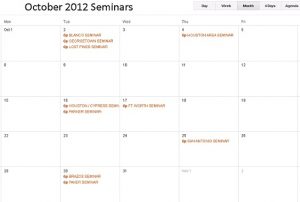




Sorry, the comment form is closed at this time.